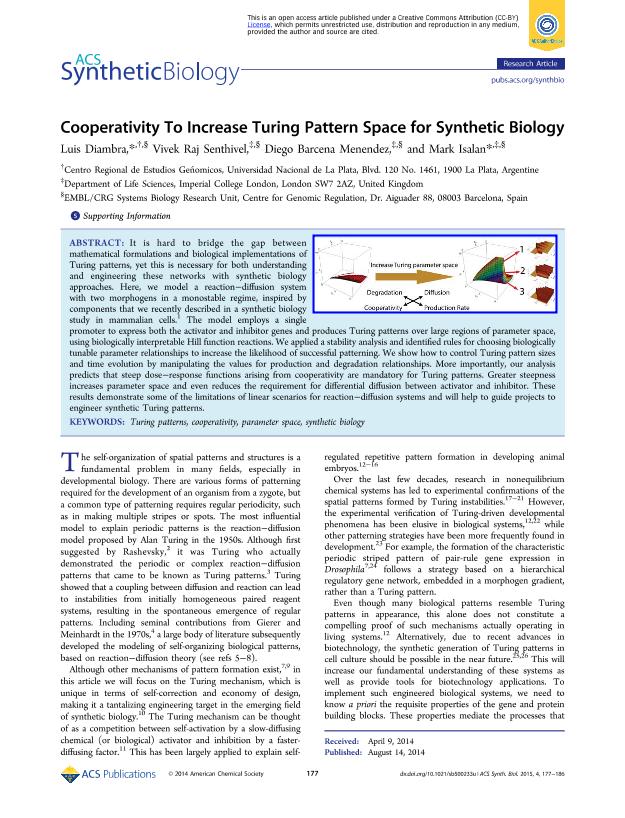Mostrar el registro sencillo del ítem
dc.contributor.author
Diambra, Luis Anibal

dc.contributor.author
Senthivel, Vivek Raj
dc.contributor.author
Barcena Menendez, Diego
dc.contributor.author
Isalan, Mark
dc.date.available
2017-03-10T21:16:14Z
dc.date.issued
2014-08
dc.identifier.citation
Diambra, Luis Anibal; Senthivel, Vivek Raj; Barcena Menendez, Diego; Isalan, Mark; Cooperativity to increase Turing Pattern space for synthetic biology; American Chemical Society; ACS Synthetic Biology; 4; 2; 8-2014; 177-186
dc.identifier.uri
http://hdl.handle.net/11336/13744
dc.description.abstract
It is hard to bridge the gap between mathematical formulations and biological implementations of Turing patterns, yet this is necessary for both understanding and engineering these networks with synthetic biology approaches. Here, we model a reaction–diffusion system with two morphogens in a monostable regime, inspired by components that we recently described in a synthetic biology study in mammalian cells.1 The model employs a single promoter to express both the activator and inhibitor genes and produces Turing patterns over large regions of parameter space, using biologically interpretable Hill function reactions. We applied a stability analysis and identified rules for choosing biologically tunable parameter relationships to increase the likelihood of successful patterning. We show how to control Turing pattern sizes and time evolution by manipulating the values for production and degradation relationships. More importantly, our analysis predicts that steep dose–response functions arising from cooperativity are mandatory for Turing patterns. Greater steepness increases parameter space and even reduces the requirement for differential diffusion between activator and inhibitor. These results demonstrate some of the limitations of linear scenarios for reaction–diffusion systems and will help to guide projects to engineer synthetic Turing patterns.
dc.format
application/pdf
dc.language.iso
eng
dc.publisher
American Chemical Society
dc.rights
info:eu-repo/semantics/openAccess
dc.rights.uri
https://creativecommons.org/licenses/by-nc-sa/2.5/ar/
dc.subject
Cooperativity
dc.subject
Parameter Space
dc.subject
Synthetic Biology
dc.subject
Turing Patterns
dc.subject.classification
Biofísica

dc.subject.classification
Ciencias Biológicas

dc.subject.classification
CIENCIAS NATURALES Y EXACTAS

dc.title
Cooperativity to increase Turing Pattern space for synthetic biology
dc.type
info:eu-repo/semantics/article
dc.type
info:ar-repo/semantics/artículo
dc.type
info:eu-repo/semantics/publishedVersion
dc.date.updated
2017-03-08T15:39:47Z
dc.identifier.eissn
2161-5063
dc.journal.volume
4
dc.journal.number
2
dc.journal.pagination
177-186
dc.journal.pais
Estados Unidos

dc.journal.ciudad
Washington DC
dc.description.fil
Fil: Diambra, Luis Anibal. Universidad Nacional de La Plata. Centro Regional de Estudios Genómicos; Argentina. Consejo Nacional de Investigaciones Científicas y Técnicas; Argentina. Centro de Regulación Genómica; España
dc.description.fil
Fil: Senthivel, Vivek Raj. Centro de Regulación Genómica; España. Imperial College London; Reino Unido
dc.description.fil
Fil: Barcena Menendez, Diego. Centro de Regulación Genómica; España. Imperial College London; Reino Unido
dc.description.fil
Fil: Isalan, Mark. Centro de Regulación Genómica; España. Imperial College London; Reino Unido
dc.journal.title
ACS Synthetic Biology
dc.relation.alternativeid
info:eu-repo/semantics/altIdentifier/doi/http://dx.doi.org/10.1021/sb500233u
dc.relation.alternativeid
info:eu-repo/semantics/altIdentifier/url/http://pubs.acs.org/doi/abs/10.1021/sb500233u
dc.relation.alternativeid
info:eu-repo/semantics/altIdentifier/url/https://www.ncbi.nlm.nih.gov/pmc/articles/PMC4384830/
Archivos asociados
